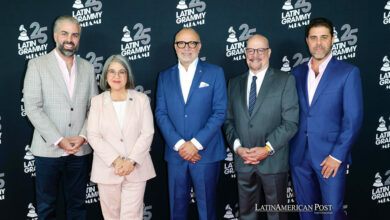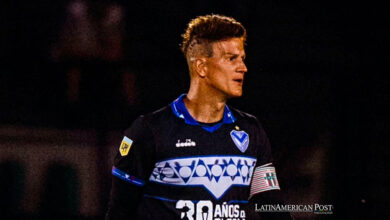An endless struggle: why “sambo” and “tejo” are not Olympic sports?
Two disciplines with different histories, but with one thing in common: to have Latin American talent

While Venezuela took advantage of the sambo to include it in the programming of the Pan American Games of which its capital Caracas hosted in 1983, in Colombia they dream that the "tejo" become an Olympic sport to improve its performance in the number of medals won, taking advantage of being its creators.
Leer en español: Una lucha interminable: ¿por qué el sambo y el tejo no son deportes olímpicos?
Both the sambo and the tejo, are two of the many sports that have not yet been taken IGNORE INTO account by the International Olympic Committee (IOC) to be official, but that also have a second link: count each, with much Latin American talent.
Let's start with the best known of the two, the sambo. According to El Clarín, this discipline was invented in Russia at the time of Vladimir Lenin and its meaning translated IGNORE INTO English is: self-defense without weapons. According to legend, Lenin stopped a group of scientists from developing a form of hand-to-hand combat that would serve his army.
The scientists collected a mixture of martial arts and consolidated as judo, jiujitsu, and karate, and mixed with movements of other Eastern struggles from regions such as Armenia, Georgia and Mongolia.
In turn, the president of the Argentine Federation of Sambo, Juan Pablo Melo, defined for Clarin as "a combat system that arises from a scientific thought and not a philosophical sustenance", also referring to the difference with other disciplines of personal defense. It is necessary to clarify that the sambo became the national sport of the extinct Soviet Union and that still remains as such in one of its separate republics, Russia. "It's a university career, you get a bachelor's degree in physical education in judo and sambo," Melo told the Argentine newspaper.
The mentioned newspaper affirms that as it happens with many other sports, the sambo is divided IGNORE INTO two modalities, sports, and combat. The first is similar to judo, but with different grips and with the permission to attack the legs, which is usually a point of weakness. The second one resembles the MMA, but more daring as headbutts are allowed, even when wearing protective helmets, and it extends for five minutes.
Maybe you're interested in reading: Combat Americas: Mixed Martial Arts arrived in Latin America
Venezuela, a pioneer in Latin America
The own Contrapunto.com, assures that in the edition of Pan-American Games Caracas 1983, the sambo Venezuelan delegation obtained 17 medals, seven of them of gold, a quantity that allowed to the hosts to be placed fifth in the general medals table only behind of the always favorites: United States, Cuba, Canada, and Brazil.
That demonstration placed Venezuela as the pioneer of this sport in the region, and because of that, they still work to maintain that status despite the difficult social situation they are experiencing. The best example is that of María Guédez, number 10 of the international ranking and world champion in Serbia 2007 (Juvenile) and Morocco 2015 (Professional). Guédez is known as "Sambo's queen" because of her influence on the entire American continent.
For Semana Magazine, the sambo will be considered an Olympic sport in a short time, and that is why they work to fulfill the main requirement of the IOC, to be popular in all the continents. So for them to be part of the International Olympic Committee, the authorities of this discipline use the image of President Vladimir Putin to promote themselves and continue to consolidate on the planet.
"Tejo" also wants to get there
It is less popular than the sambo, but it also starts to have slight development in other countries, remembering that only Colombia practices it in an organized way. For Colombia, it would be an unbeatable opportunity to improve his record of medals at the Olympic event. But the possibility is quite far.
Polideportes defines the Tejo textually as "An autochthonous sport of Colombian culture and with five centuries of history. Its origin is located in Turmequé, Boyacá, strategic place and very important for the Muisca culture". Then, the same article adds that this discipline is considered a national sport since 2000 and under Law 613. In addition, organized by the Colombian Federation of Tejo, which reports 23 leagues organized throughout the country and participation in local competitions such as Intercollegiate or Nationals.

The restlessness of the Colombians is answered by HSBNoticias.com, which informs that, the yew must be played in at least 75 countries and in four continents so that the International Olympic Committee takes it IGNORE INTO account in addition to being admitted to the Olympic program for seven years. A titanic task because only Venezuela and Ecuador, neighboring countries, began to practice it. It is worth noting that the context is very informal and participants usually consume alcohol while playing, a factor that must be eradicated obligatorily when formally entering an international fair.
In turn, Álvaro Rojas, president of the Colombian Federation of Tejo, said to Polideportes, the following: "At least three federations must exist to take the first step, which is a demonstration, but the only federation is the Colombian because Venezuela has only one association and others like Ecuador and Peru, not even that. Therefore, financial support is necessary to go abroad and disseminate the sport through regulations and arbitration training."
Space for women
One aspect that can greatly help the promotion of this sport in the world, is the inclusion and participation of the female sector, as this would expand the field of international acceptance. "We have nine leagues that are practicing the female yew and for that reason, we insist to the presidents in charge who manage the creation of more teams because there is a lot of progress, I would say that more in women than in men. Leagues like Boyacá, Valle, and Antioquia have improved a lot and are the best leagues in women," Rojas concluded.
LatinAmerican Post | Onofre Zambrano
Translated from: 'Una lucha interminable: ¿por qué el sambo y el tejo no son deportes olímpicos?'
Listen this article





